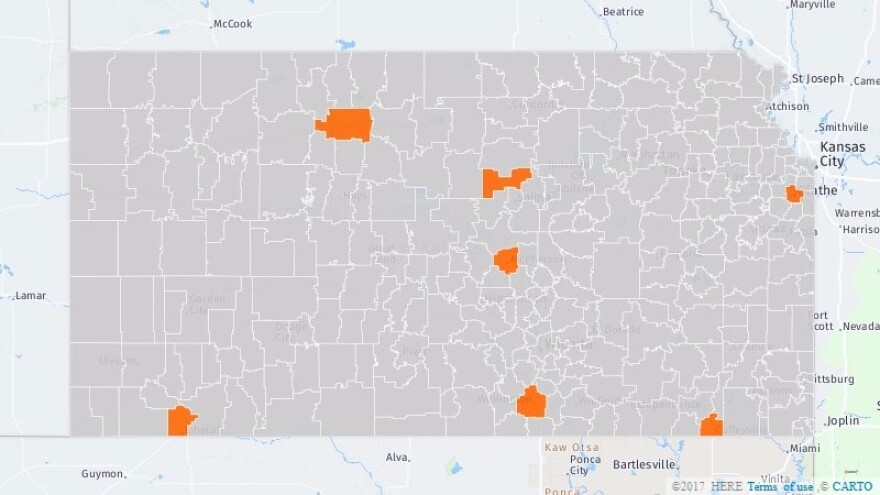Fourteen schools in seven school districts across Kansas will work this year on revamping the way they serve children, with the goal of becoming statewide models for overhauling primary and secondary education.
The education department is branding the effort to re-envision schools as Kansas’ version of “a moon shot,” referring to the U.S. race to put a man on the moon in the 1960s.
The participants announced Tuesday range in size from the Kansas City area’s 29,000-student Olathe school district — the state’s second-largest — to the 340-student rural Stockton district in northwest Kansas.
In each district, one elementary school and one secondary school will join the effort. The schools will collaborate with the state education department, which is promoting a vision that focuses more on the individual goals of students and less on standardized testing.

Among other things, this vision involves having schools work with secondary students to develop individualized plans of study that help them explore their career aspirations — such as through internships and career classes — and identify appropriate steps, which might include pursuing college for some and technical education or other training for others.
Little information was available as to the concrete changes schools will carry out. Teachers and administrators will have leeway in shaping their efforts locally but will be expected to build and launch their schools’ redesign plans within a year.
Randy Watson, education commissioner, outlined the project during the Kansas State Board of Education meeting in Topeka. Asked how the schools would achieve successful overhauls on a short timeline — academics have spent decades researching how to improve schools — Watson said Kansas is rethinking the system as a whole.
“We’re about — in 12 months — to invert the system and be totally focused on the child,” he said. “This has got to be about teacher voice and student voice. And then it has to be not about, ‘What English credits do I need?’ it’s ‘What do I need to be successful at what I want to become?’”

The schools will not receive extra dollars to achieve their goals but will have support from the education department and outside education and youth groups.
The student bodies at the participating schools vary demographically and include some with significant proportions of children from low-income or minority backgrounds. Kansas, like the country as a whole, is trying to address low academic achievement among students in racial minority groups or from low-income families.
The moon-shot initiative did not attract applications from the state’s largest urban, high-poverty districts: Wichita, Kansas City and Topeka.
The seven participating districts and their schools are:
- Coffeyville USD 445, Community Elementary School and Field Kindley Memorial High.
- Liberal USD 480, Meadowlark Elementary School and Liberal High School.
- McPherson USD 418, Eisenhower Elementary School and McPherson Middle School.
- Olathe USD 233, Westview Elementary School and Santa Fe Trail Middle School.
- Stockton USD 271, Stockton Grade School and Stockton High School.
- Twin Valley USD 240, Tescott Elementary School and Bennington Junior-Senior High School.
- Wellington USD 353, Kennedy Elementary School and Wellington High School.
Each district will have one of the seven astronauts from the Mercury spaceflight program as its symbol for the effort.
Asked about the optics of the department’s decision to represent its new program with seven white, male astronauts at a time when schools are trying to close achievement gaps for minority children, present students with more role models of color and encourage girls to pursue science and math careers, Watson said the astronaut metaphor is apt because the Mercury 7 stepped up to a historic challenge.
“When we say ‘every child,’ that’s Hispanic, female, male, urban, suburban. It’s everyone.” — Randy Watson, Kansas education commissioner
“What’s important is, just like those seven people didn’t know what they were getting into and Kennedy issued a challenge, the nation responded,” he said. “And that’s what we hope Kansas will do.”
Watson, former superintendent of McPherson schools, emphasized the department and Kansas State Board of Education’s goal of improving outcomes for all students.
“When we say ‘every child,’” he said, “that’s Hispanic, female, male, urban, suburban. It’s everyone.”
Lt. Gov. Jeff Colyer also spoke at the launch, congratulating education officials on the initiative.
“Kansas wants to lead the world in the success of each student,” Colyer said, referencing the education department’s stated mission. “I want to say thank you for what all of you do to help lead us in that direction.”
Colyer announced shortly afterward that he will run for governor.
Celia Llopis-Jepsen is a reporter for the Kansas News Service, a collaboration of KCUR, Kansas Public Radio and KMUW covering health, education and politics. You can reach her on Twitter @Celia_LJ. Kansas News Service stories and photos may be republished at no cost with proper attribution and a link back to kcur.org.







